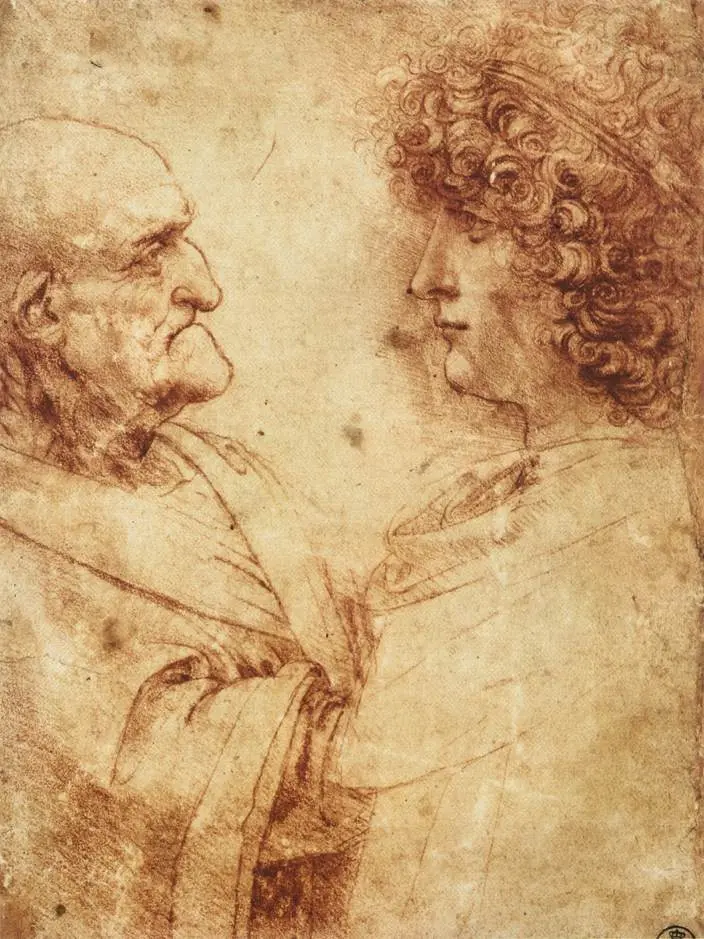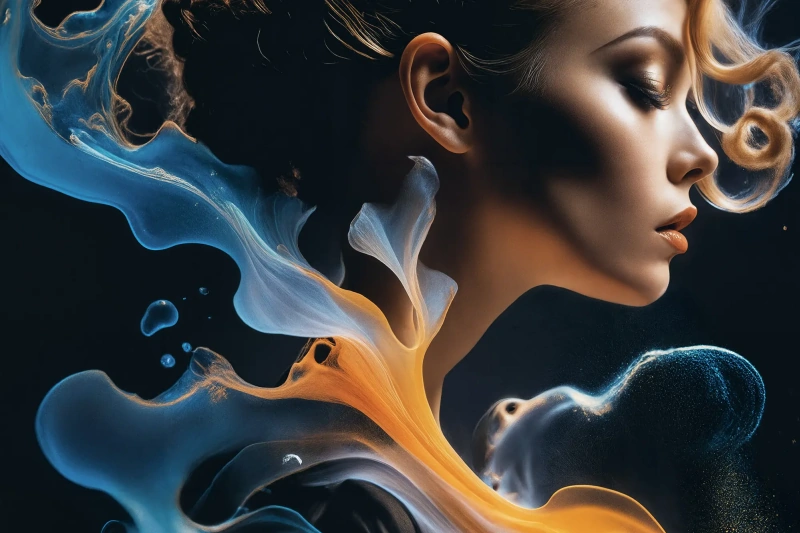The genius' vivid imagination stimulates the progress but pushes the person to utterly extravagant deeds. How Matisse overcame his phobia, why Caravaggio was forced to threaten the sitters, and who was firing at flies? Answers to these questions are in the stories below, where the artists appear as huge originals.

Leonardo da Vinci: without sleep, but with ciphers
The great Leonardo reckoned that life is too interesting to waste time on sleep! The genius slept for only 4 hours a day. He admired creating secret messages: he wrote letters backwards to read them in a mirror.
Leonardo encoded personal messages as well as records of his inventions. Perhaps, the master believed that humanity is not yet ready for this information, which meant hiding all discoveries in puzzles for future generations. In addition, the artist loved to leave the work unfinished, for incompleteness implies continuation. While a painting is not finished, it is still alive.
Leonardo encoded personal messages as well as records of his inventions. Perhaps, the master believed that humanity is not yet ready for this information, which meant hiding all discoveries in puzzles for future generations. In addition, the artist loved to leave the work unfinished, for incompleteness implies continuation. While a painting is not finished, it is still alive.
The heads of old and young men
1495, 20.8×15 cm
Salvador Dali: dreams and reality with no borders
A talented man with a big mustache liked to shock the audience: to walk along the street with an anteater, to give an interview on a tree, to give lectures in a diving suit, claiming that in such an attire it’s easier for him to swim in the ocean of his subconscious.

Photo: Philippe Halsman
When the artist’s older brother has died, parents hurried to bore a second child to forget their grief. They named him Salvador, after their firstborn son. In his memoirs, Dali wrote that all his oddities were an attempt to prove his existence to himself, to make sure that he was not a replica of his older brother.
It is unlikely that his strangeness was a far-fetched commercial image of Dali. Rather, thanks to his muse Gala, he managed to turn his flaws into virtues, making fads an advantage.
It is unlikely that his strangeness was a far-fetched commercial image of Dali. Rather, thanks to his muse Gala, he managed to turn his flaws into virtues, making fads an advantage.
The hallucinogenic toreador
1970, 400×300 cm
Once, being a guest at the Paris hotel Le Meurice, Dali asked to bring a flock of sheep to his room, and then began shooting them blank. Another time, the artist asked the staff to catch flies for him in the Tuileries garden. For each Salvador paid five francs.
Perhaps, the artist needed flies for some kind of installation. After all, Jan Fabre has made a series of art works made of the beetles' wings. Dali could well have anticipated the trend to use insects for art!
Picasso: shooting but not on pigeons
Another great Spaniard also liked to shoot: returning to the Bateau-Lavoir in the morning, the artist shot into the air just for pleasure. To recall, Le Bateau-Lavoie is a famous hostel in the Montmartre, where lived Picasso, Modigliani and many other artists.
In a hostel the young artist could not get his household, but in his own house the adult Picasso always kept pigeons. Henri Matisse gifted him several of them.
The Spaniard liked to draw these birds long before he created his Dove of Peace. When he was a child, his father, the painter José Ruiz y Blasco, instructed him to finish paws of pigeons.
Picasso joked that he did not understand why this bird was chosen as a symbol of peace. In his opinion, the pigeons were the most grumpy winged and could easily peck each other to death for a crumb of bread.
Henri Matisse: the main thing is to be safe

Matisse had some few oddities, as for an artist. The most notable was his fear to be a cast-off. The master was afraid to lose his sight, so he learned to play the violin to work as a street musician, if needed.
In general, Matisse did not have any other obvious quirks, except for his vivid dislike for the art dealer Ambroise Vollard.
Music lesson
1917, 99×84 cm
Andy Warhol: cold as ice
The artist had an analytical mind, developed logic and ability to anticipate reactions on many events and deeds. Sometimes these traits took shape of the frightening, emotionless coldness of the pop-art king.

When Andy Warhol has heard that his friend, Fred Herko, a regular visitor to the ‘Factory', committed suicide by throwing himself from one of its windows, his reaction was baffling and cold, "I wish Freddy had told us about his plans; we could have filmed it."
By the way, you should definitely remember the famous Campbell soup can, eternalized by Warhol. When Andy has become a wealthy man, he still could not deny himself the pleasure to dine this 5-cent soup and often ate it straight from a jar.
Caravaggio: the offender throughout
Genious artist, he lived a vagabond life, preferring companies of courtesans, vagrants, partygoers at drinking establishments. It is the relationship with a courtesan that made Caravaggio a criminal. The girl posed for his canvas "Saint Catherine of Alexandria." The artist quarreled with another of her fellow favourite and fatally shot him in a fight.
Illustration: alleged self-portrait of the artist, playing role of a Bacchus.
Illustration: alleged self-portrait of the artist, playing role of a Bacchus.
The Resurrection Of Lazarus
1609, 380×275 cm
One day, in Messina, Caravaggio met a wealthy merchant Giovanni Battista De Lazzari, who ordered him a painting. The artist decided to depict Saint Lazarus, a patron saint of the customer. Since Caravaggio loved to paint from nature, in order to get a realistic canvas "The Raising of Lazarus" he ordered two sitters to hold the body of a deceased young man for many hours in a row. At first, they refused, but Caravaggio threatened them with a knife, and the models resigned to the master’s idea.
More about the rebellious life of Caravaggio read in our separate article.
Michael Vrubel: a pest for himself
Suffering from unrequited love, Vrubel has cutting himself with a knife. Emilia, the lady of his heart, was a wife of an archaeologist and culturologist Adrian Prakhov, who supervised the frescoes painting in the Vladimir Cathedral in Kiev.
Feelings have passed, but scars remained, as well as the portrait of Emilia in the image of the Virgin Mary, which is in the church of St. Cyril.
Once again we are talking about the oddities: an unbearable character, drunkenness, a habit to splash out money and to spoil his own paintings. Mikhail Vrubel would have been approached by the words that Edgar Degas once said to James Whistler, "You are the strangest man I know. It’s good that you are a genius at least."
Antonio Gaudi: contempt for the material world
In his final years, the great architect was so carried away by his eternal work that he stopped to take care of his clothes and ignored surrounding world in general. It was strange, because in his youth Gaudi was famous both for his talent and for his impeccable style, costumes and habit of traveling around construction sites on his own cortege.
Park Güell (photo: abilolando.com)
In his old age, Gaudi was sometimes mistaken for a beggar. He could go out in different shoes or forget to eat. He was mortally injured in an accident: when carried away by his thoughts, he was run over by a tram. The cabmen did not want to take the dirty old man to the hospital. As a result, he was taken to a clinic for the poor. Unfortunately, the great man could not be saved. The genius who gave Europe the Casa Vicens, the Casa Batlló, the Sagrada Familia (Basilica and Expiatory Church of the Holy Family), later on granted World Heritage status by UNESCO, and many other masterpieces of the architecture as well, died in poverty.
His body was buried in the crypt of the edifice of the Sagrada Familia, which has been constructed since 1882 and continues to this day.
Van Gogh was fond of frenology, linking the shape of a human skull with the psychological traits of an individual. Titian preferred lustrous ladies and adored taxis — the stagecoaches. Nikolai Ge poured aphorisms and denied the beauty of a man, raised oats and laid stoves… Don`t miss a series of ARTHIVE articles "Strokes to the portrait…" revealing the artists in a completely new way.
The potato eaters
May 1885, 81×114 cm
Main illustration: photo of Salvador Dali by Tony Saulnier (for Paris Match).



























